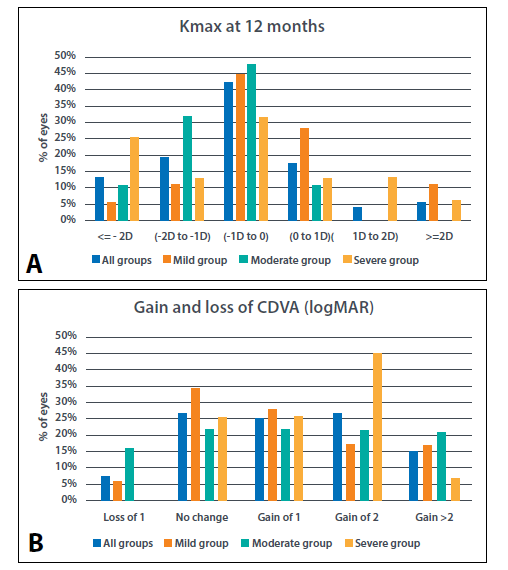Oxygen Breathes New Life into KC Management
Since the approval of corneal collagen cross-linking (CXL) for keratoconus (KC) management, several modifications of the original epithelium-off Dresden CXL protocol have been described to overcome the shortcomings of treatment duration and patient discomfort while aiming for equal outcomes.

Dermot McGrath
Published: Monday, July 4, 2022
Amongst the most popular changes have been the accelerated and epithelium-off (transepithelial) protocols. Meanwhile, a number of assistive devices and adjuncts for oxygen delivery have been designed to enhance the pharmacological effectiveness of riboflavin, and pulsed, higher- fluence UVA regimes are used to improve oxygen diffusion.
In this regard, Dr Brendan Cronin and colleagues published their one-year outcomes of a modified accelerated, epithelium-on, oxygen-supplemented CXL protocol. A combination of methods was employed to increase riboflavin permeability through corneal epithelium and enhance stromal oxygen concentration while reducing oxygen consumption. Key components were the use of two riboflavin types (0.25% with BAK, 4 minutes; 0.22% BAK-free, 6 minutes), a wearable oxygen delivery device to induce a hyperoxic periocular environment, and accelerated, pulsed, high-fluence UVA irradiance of 10 J/cm2 total energy used for 11 minutes 6 seconds in total.
Fifty-three eyes of patients between 13 and 45 years old with progressive KC of all grades that underwent CXL were studied retrospectively. The authors demonstrated mean CDVA improvement, with no change in any of the keratometric and refractive parameters or higher-order aberrations, with no complications, concluding the protocol is safe and effective in achieving KC stabilisation at 12 months.
DISCUSSION WITH CORNEAL EXPERTS
The ESCRS Eye Journal Club discussed the protocol and study outcomes with cornea specialists Dr David Lockington (Glasgow) and Dr Vasilios Diakonis (Athens). Amongst the observations made by the experts were the need to use contemporary grading systems for KC severity, such as the Belin ABCD staging system, and apply universal criteria to define KC progression—an area with apparent lack of consensus in the cornea community. Consolidating terminology and criteria is essential to facilitate larger, combined studies and meta-analyses, especially considering the plethora of emerging modified CXL protocols that claim good outcomes but are hampered by small sample sizes, short follow-up, and mixed populations (paediatric/adult).
Regarding the study’s primary outcomes – CDVA and Kmax – both Drs Lockington and Diakonis concurred the vision correction method (spectacles versus rigid contact lenses) is a key determinant of CDVA assessment in a KC population of varied severity and therefore essential information in the article. They noted how CDVA improved significantly in this cohort while none of the studied parameters changed. Kmax was reported stable over 12 months of follow-up, although five eyes (about 10%) experienced Kmax deterioration of less than 1 D. This was not considered significant in view of stable CDVA, an approach the experts were sceptical about, as the primary aim of CXL treatment is keratometric stability rather than CDVA improvement.
While there are certain advantages in epithelium-on CXL protocols, their efficacy in attaining KC stability remains debatable. Increasingly, more adjunct devices are developed to overcome the epithelium’s barrier function, with several studies – some of which industry-funded – reporting promising outcomes. When asked about their personal preference, both Drs Lockington and Diakonis apply epithelium-off accelerated protocols in their practice and anticipate that robust, comparative future studies with longer follow-up should facilitate decisions on CXL protocol choices.
EyeJC, the ESCRS Journal Club, can be watched live online every month. The hosts include Artemis Matsou, Imran Yusuf, and Basak Bostanci. It is archived at https://player.escrs.org.
Reference:
Cronin B, Ghosh A, Chang C. “Oxygen-supplemented Transepithelial
Accelerated Corneal Crosslinking with Pulsed Irradiation for Progressive
Keratoconus: One-Year Outcomes.” Journal of Cataract & Refractive Surgery.
2022 Apr 4.

Latest Articles
Towards a Unified IOL Classification
The new IOL functional classification needs a strong and unified effort from surgeons, societies, and industry.
The 5 Ws of Post-Presbyopic IOL Enhancement
Fine-tuning refractive outcomes to meet patient expectations.
AI Shows Promise for Meibography Grading
Study demonstrates accuracy in detecting abnormalities and subtle changes in meibomian glands.
Are There Differences Between Male and Female Eyes?
TOGA Session panel underlined the need for more studies on gender differences.
Simulating Laser Vision Correction Outcomes
Individualised planning models could reduce ectasia risk and improve outcomes.
Need to Know: Aberrations, Aberrometry, and Aberropia
Understanding the nomenclature and techniques.
When Is It Time to Remove a Phakic IOL?
Close monitoring of endothelial cell loss in phakic IOL patients and timely explantation may avoid surgical complications.
Delivering Uncompromising Cataract Care
Expert panel considers tips and tricks for cataracts and compromised corneas.
Organising for Success
Professional and personal goals drive practice ownership and operational choices.